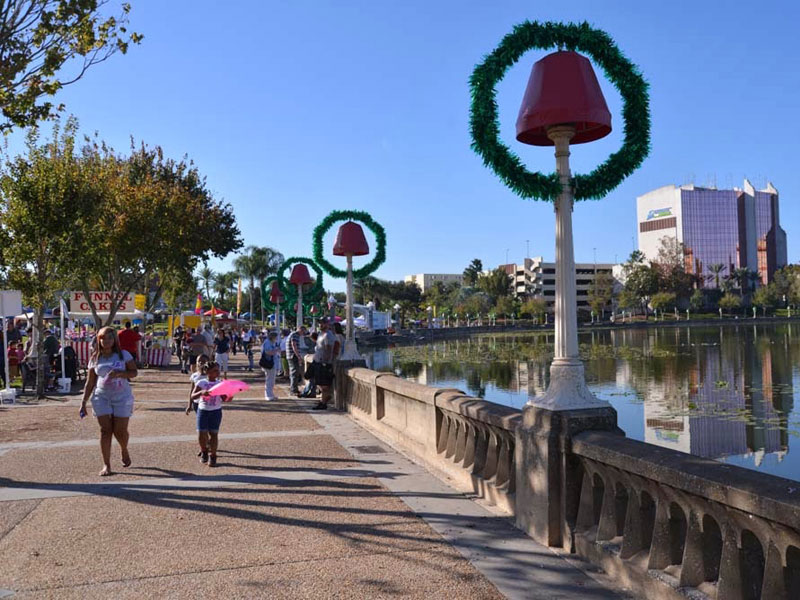Lake Mirror Park: Lakeland, Florida

Summary
Lake Mirror Park is the centerpiece and crown jewel of downtown Lakeland, Florida. As the January 1930 issue of National Geographic wrote about the area around the lake: "Like an ornate entrance to some vast Venetian palace looms the Civic Center of Lakeland."
Designated Area
Bounded by South Massachusetts Avenue, East Main Street, South Lake Avenue, South Iowa Street, and East Orange Street.

Finish line of annual Mayfaire 5k run. Photo courtesy City of Lakeland.
Planning Excellence
The park was conceived on the back porch of Tom Appleyard, president of the Chamber of Commerce at the time. Lake Mirror covers 18 of the park's 32 acres. There are seven acres of open space surrounding the lake, and an additional seven acres of parks, public recreation, and leisure facilities.
The most prominent and unique feature of the park is the promenade and loggia that is one of Florida's best examples of the "City Beautiful" movement from the 1920s. Architect Charles Wellford Leavitt's design includes ornamental lamp posts and Corinthian columns that define the west side of the Promenade. The structure rises above Lake Mirror creating a vista to the east. Surrounding the park are a number of historic buildings including the New Florida Hotel, now known as the Lake Mirror Tower Apartments, and the Manolia Building, which contribute to the character of the park.
After several decades of neglect in the 1960s and 1970s, an engaged group of local citizens formed Historic Lakeland that worked to restore Lake Mirror Park to its former glory. These efforts resulted in the park's listing on the National Register of Historic Places in 1983. The city established the Community Redevelopment Area and developed and implemented a master plan for the park that was completed in 2010.
Lake Mirror Park has become the center of activity in the community and is the only location in the city that can accommodate large and diverse events. The park provides ample open space for residents, employees, and visitors to recreate, socialize, or restfully enjoy the scenery.

People sitting on the lawn overlooking Lake Mirror during a free concert. Photo by Tom Hagerty.
Defining Characteristics, Features
Early History
- Lakeland Chamber of Commerce President John Appleyard conceived the idea of Lake Mirror Park; gained community support and funding for construction (1923)
- Architect Charles Wellford Leavitt designed master plan for the park (1924)
- Promenade and loggia constructed (1926-1928)
- Featured in National Geographic magazine as "the crown jewel of the south" (1930)
- Promenade was renamed "Francis Langford Promenade" in honor of the actress and singer from Lakeland (1946)
- Florida Department of Transportation extended Lemon Street as a state business route on the south side of Lake Mirror (1953)
Redevelopment
- Downtown Lakeland Community Redevelopment Area was established and led to a number of major capital investment projects, including Lake Mirror Park (1979)
- Listed on the National Register of Historic Places (1983)
- Florida Department of Historic Preservation Grant in the amount of $70,000 was awarded for the restoration project prepared for the city a few years earlier through a restoration and feasibility analysis (1983)
- Lemon Street was removed from the south shore of Lake Mirror to restore safe pedestrian access to the park (1998)
- A master plan was developed based on the original vision of Charles Wellford Leavitt (2001)
- Goals laid out by the master plan were completed (2010)
- Current efforts are focused on guiding private development adjacent to the park to complement and maximize the park"s use
Design and Features
- Promenade and loggia an example of "City Beautiful" movement (1928)
- Hollis Garden is a botanical garden that features a central ellipse, lily pad pool, several fountains and sculptures, abundant native plant life
- Barnet Family Park features a play area designed for preschoolers; also features a splash pad and picnic area
- An aesthetically pleasing stormwater pond was built to improve water quality; collects stormwater runoff that would drain from downtown streets and pollute Lake Mirror
- Recycled materials used throughout the park, including recycled glass in the concrete benches and picnic tables in the playground areas, recycled rubber as a safety surface in the play areas, and recycled tires in lieu of landscape mulch
- One of many sculptures throughout the park, The Tribute to the Volunteer Spirit stands prominently on the Lake Mirror shoreline
- A significant collection of preserved historic buildings surround the park and contribute to the character and sense of place, including the New Florida Hotel (1935) and Magnolia Building (1938)

People walking along the promenade and winter holiday decorations. Photo by Tom Hagerty.
Events
- The park hosts over 18 major community events each year, attended by more than 170,000 people
- The most widely attended annual events are the Christmas parade (20,000 attendees) and the classic car show (10,000 attendees)


